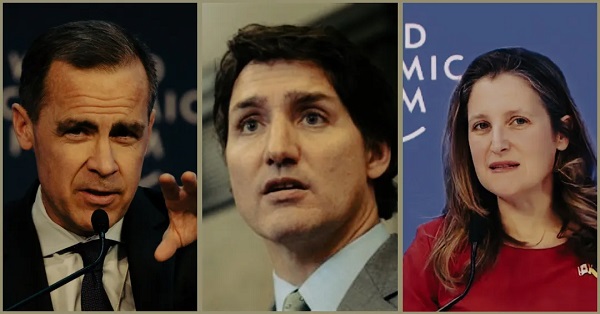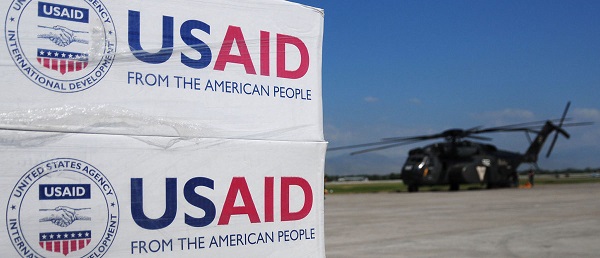Business
StatsCan Report Confirms Canada’s Middle Class Is Disappearing Under Liberal Mismanagement

A new Statistics Canada report reveals widening income inequality and a shrinking middle class, all while Trudeau’s Liberals push policies that benefit the wealthy and punish working Canadians.
A newly released report from Statistics Canada on household economic accounts for the third quarter of 2024 confirms what many Canadians have long suspected—while the wealthiest continue to rake in profits, middle- and lower-income families are left struggling under the weight of economic policies that seem designed to work against them. The report, released today, paints a stark picture of a country where financial inequality is not just persisting, but growing.
The numbers don’t lie. Income inequality has increased, with the top 40% of earners pulling even further ahead of the bottom 40%. The gap in disposable income between these two groups expanded to 46.9 percentage points, up from 46.3 just a year ago. The highest-income households saw their disposable income rise by 6.8%, largely driven by soaring investment gains, while the poorest Canadians saw only a 3.7% increase, barely enough to keep up with the cost of living. Meanwhile, middle-income earners experienced sluggish wage growth of just 2.7%, well below the national average.
Despite declining interest rates, lower-income households found themselves paying more on mortgages and consumer credit, while the wealthy reaped the benefits of higher investment yields. The data shows that middle-income households, who are already feeling the squeeze from inflation and stagnating wages, saw their share of national income shrink.
The most revealing statistic is in net worth distribution. The top 20% of wealthiest Canadians control nearly two-thirds (64.7%) of the country’s net worth, averaging an eye-watering $3.3 million per household. Meanwhile, the bottom 40% hold just 3.3%, barely scraping by with an average of $83,189 in assets.
However, the real estate market has provided a rare silver lining for some lower-wealth households, as they were able to take advantage of slightly more favorable conditions to buy homes, increasing their net worth at the fastest pace. But even that gain is tempered by the reality that housing costs remain unaffordable for many, and young Canadians under 35 continue to pull back from homeownership altogether.
Let’s be clear—this isn’t happening by accident. This is what happens when you let a government of self-serving narcissists run the country into the ground. Justin Trudeau and his Liberal Party have spent nearly a decade dismantling the Canadian economy, pushing a radical, ideologically driven agenda that benefits their elite donor class while leaving working Canadians behind. And now, as the country crumbles under the weight of their incompetence, Trudeau is running for the exits, leaving the mess to whoever’s foolish enough to take the job.
And what do they do on the way out? Do they work to secure our economy? To make life more affordable? To protect Canadian workers? No. Instead, they decide to pick a fight with the United States. Donald Trump, who actually puts his country first—imagine that—announces a 25% tariff on Canadian imports, a move meant to address drug trafficking and illegal immigration, and what’s the Liberals’ response? Do they try to work out a deal? Do they negotiate in good faith to protect Canadian jobs? No. Instead, Chrystia Freeland comes out swinging, proposing retaliatory tariffs that will hurt Canadian businesses just as much, if not more, than they’ll hurt the U.S.
This isn’t about protecting Canada. This isn’t about securing the border or fighting for our economy. This is about pure, partisan politics. The Liberal base wants conflict with the U.S. Not because it’s good for the country, but because their fragile, self-righteous worldview depends on it. They hate Trump, and they hate that his America-First policies are actually working for American workers. So instead of finding a solution, they escalate. They antagonize. Because their base loves it. Not because Canada benefits, but because Liberals benefit.
Subscribe to The Opposition with Dan Knight .
For the full experience, upgrade your subscription.
And meanwhile, what’s Jagmeet Singh doing? The man who loves to talk about standing up for the working class? He could pull the plug on this corrupt government today with a non-confidence motion. But he won’t. Because, like every other member of the political elite in this country, he’s more interested in protecting his own position than actually doing his job. He makes noise about fighting for Canadian workers, but when the moment comes to act, he folds—again.
So here we are. The economy is in shambles. The wealth gap is growing. The middle class is getting squeezed to death. And the people in charge are too busy playing partisan games to do anything about it. Trudeau is leaving, but his legacy of economic destruction, division, and incompetence will live on through the same out-of-touch Liberal elites who put us in this mess.
But here’s the thing—Canada is better than this. We are a nation built on hard work, freedom, and opportunity, not on government control, reckless spending, and endless excuses. We are a country that thrives when its people—not bureaucrats in Ottawa—decide their own future.
It’s time for Canadians to take their country back. It’s time to put an end to this cycle of economic ruin and government failure. We don’t need more empty promises, more excuses, or more Liberal arrogance. We need an election. We need leaders who believe in the strength of Canadians, not the power of government.
Enough is enough. If we want a future where hard work is rewarded, where families can afford to buy a home, and where our economy is built to benefit all Canadians—not just the elite—then we must act. This country belongs to you, not the Liberal Party, not the special interests, and certainly not the self-serving political class in Ottawa.
Canada deserves better. And the time to demand it is now.
Subscribe to The Opposition with Dan Knight .
For the full experience, upgrade your subscription.
Business
Trump confirms 35% tariff on Canada, warns more could come

Quick Hit:
President Trump on Thursday confirmed a sweeping new 35% tariff on Canadian imports starting August 1, citing Canada’s failure to curb fentanyl trafficking and retaliatory trade actions.
Key Details:
- In a letter to Canadian Prime Minister Mark Carney, Trump said the new 35% levy is in response to Canada’s “financial retaliation” and its inability to stop fentanyl from reaching the U.S.
- Trump emphasized that Canadian businesses that relocate manufacturing to the U.S. will be exempt and promised expedited approvals for such moves.
- The administration has already notified 23 countries of impending tariffs following the expiration of a 90-day negotiation window under Trump’s “Liberation Day” trade policy.
Diving Deeper:
President Trump escalated his tariff strategy on Thursday, formally announcing a 35% duty on all Canadian imports effective August 1. The move follows what Trump described as a breakdown in trade cooperation and a failure by Canada to address its role in the U.S. fentanyl crisis.
“It is a Great Honor for me to send you this letter in that it demonstrates the strength and commitment of our Trading Relationship,” Trump wrote to Prime Minister Mark Carney. He added that the tariff response comes after Canada “financially retaliated” against the U.S. rather than working to resolve the flow of fentanyl across the northern border.
Trump’s letter made clear the tariff will apply broadly, separate from any existing sector-specific levies, and included a warning that “goods transshipped to evade this higher Tariff will be subject to that higher Tariff.” The president also hinted that further retaliation from Canada could push rates even higher.
However, Trump left the door open for possible revisions. “If Canada works with me to stop the flow of Fentanyl, we will, perhaps, consider an adjustment to this letter,” he said, adding that tariffs “may be modified, upward or downward, depending on our relationship.”
Canadian companies that move operations to the U.S. would be exempt, Trump said, noting his administration “will do everything possible to get approvals quickly, professionally, and routinely — In other words, in a matter of weeks.”
The U.S. traded over $762 billion in goods with Canada in 2024, with a trade deficit of $63.3 billion, a figure Trump called a “major threat” to both the economy and national security.
Speaking with NBC News on Thursday, Trump suggested even broader tariff hikes are coming, floating the idea of a 15% or 20% blanket rate on all imports. “We’re just going to say all of the remaining countries are going to pay,” he told Meet the Press moderator Kristen Welker, adding that “the tariffs have been very well-received” and noting that the stock market had hit new highs that day.
The Canadian announcement is part of a broader global tariff rollout. In recent days, Trump has notified at least 23 countries of new levies and revealed a separate 50% tariff on copper imports.
“Not everybody has to get a letter,” Trump said when asked if other leaders would be formally notified. “You know that. We’re just setting our tariffs.”
Business
Trump slaps Brazil with tariffs over social media censorship

From LifeSiteNews
By Dan Frieth
In his letter dated July 9, 2025, addressed to President Luiz Inácio Lula da Silva, Trump ties new U.S. trade measures directly to Brazilian censorship.
U.S. President Donald Trump has launched a fierce rebuke of Brazil’s moves to silence American-run social media platforms, particularly Rumble and X.
In his letter dated July 9, 2025, addressed to President Luiz Inácio Lula da Silva, Trump ties new U.S. trade measures directly to Brazilian censorship.
He calls attention to “SECRET and UNLAWFUL Censorship Orders to U.S. Social Media platforms,” pointing out that Brazil’s Supreme Court has been “threatening them with Millions of Dollars in Fines and Eviction from the Brazilian Social Media market.”


Trump warns that these actions are “due in part to Brazil’s insidious attacks on Free Elections, and the fundamental Free Speech Rights of Americans,” and states: “starting on August 1, 2025, we will charge Brazil a Tariff of 50% on any and all Brazilian products sent into the United States, separate from all Sectoral Tariffs.” He also adds that “Goods transshipped to evade this 50% Tariff will be subject to that higher Tariff.”
Brazil’s crackdown has targeted Rumble after it refused to comply with orders to block the account of Allan dos Santos, a Brazilian streamer living in the United States.
On February 21, 2025, Justice Alexandre de Moraes ordered Rumble’s suspension for non‑compliance, saying it failed “to comply with court orders.”
Earlier, from August to October 2024, Moraes had similarly ordered a nationwide block on X.
The court directed ISPs to suspend access and imposed fines after the platform refused to designate a legal representative and remove certain accounts.
Elon Musk responded: “Free speech is the bedrock of democracy and an unelected pseudo‑judge in Brazil is destroying it for political purposes.”
By linking censorship actions, particularly those targeting Rumble and X, to U.S. trade policy, Trump’s letter asserts that Brazil’s judiciary has moved into the arena of foreign policy and economic consequences.
The tariffs, he makes clear, are meant, at least in part, as a response to Brazil’s suppression of American free speech.
Trump’s decision to impose tariffs on Brazil for censoring American platforms may also serve as a clear signal to the European Union, which is advancing similar regulatory efforts under the guise of “disinformation” and “online safety.”
With the EU’s Digital Services Act and proposed “hate speech” legislation expanding government authority over content moderation, American companies face mounting pressure to comply with vague and sweeping takedown demands.
By framing censorship as a violation of U.S. free speech rights and linking it to trade consequences, Trump is effectively warning that any foreign attempt to suppress American voices or platforms could trigger similar economic retaliation.
Reprinted with permission from Reclaim The Net.
-

 International2 days ago
International2 days agoSecret Service suspends six agents nearly a year after Trump assassination attempt
-

 Bruce Dowbiggin1 day ago
Bruce Dowbiggin1 day agoThe Covid 19 Disaster: When Do We Get The Apologies?
-

 Crime21 hours ago
Crime21 hours agoSweeping Boston Indictment Points to Vast Chinese Narco-Smuggling and Illegal Alien Labor Plot via Mexican Border
-

 Alberta1 day ago
Alberta1 day agoAlberta school boards required to meet new standards for school library materials with regard to sexual content
-

 Business2 days ago
Business2 days agoWEF-linked Linda Yaccarino to step down as CEO of X
-

 Automotive2 days ago
Automotive2 days agoAmerica’s EV Industry Must Now Compete On A Level Playing Field
-

 Environment21 hours ago
Environment21 hours agoEPA releases report on chemtrails, climate manipulation
-

 Business2 days ago
Business2 days ago‘Experts’ Warned Free Markets Would Ruin Argentina — Looks Like They Were Dead Wrong





